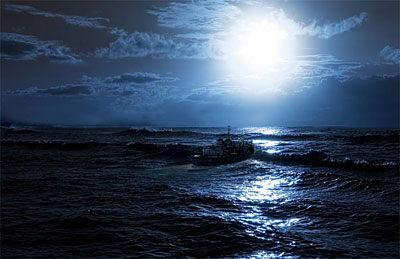February/March 2014 | View this story as a .pdf
The former Maine Maritime Academy midshipman was lost at sea. But who “losted” her?
By Colin W. Sargent
 Whatever happened to that woman who got kicked out of Maine Maritime Academy for not wearing her uniform? Carelessly, you crack open a Portland Press Herald and let your eyes wander until a small black square floats exotically to your attention about 360 miles from land, near the Persian Gulf port of Bahrain:
Whatever happened to that woman who got kicked out of Maine Maritime Academy for not wearing her uniform? Carelessly, you crack open a Portland Press Herald and let your eyes wander until a small black square floats exotically to your attention about 360 miles from land, near the Persian Gulf port of Bahrain:
We can only guess at what happened, guess and wonder what was in the sealed envelope that was found with Barbara DiNinno’s neatly packed belongings after she disappeared on March 9 from the decks of the Military Sealift Command ship Courier. I know what’s inside the sealed letter, but before we steam it open, let’s hold it up to the light and consider the person who addressed it.
”It is to be noted that no life rings, life jackets, survival suits, etc., are missing. If DiNinno is overboard, which appears obvious, she is without any flotation assistance,” writes the Courier’s captain in his mishap report.
It is also to be noted that this missing person is the same Barbara DiNinno whose controversial expulsion from Maine Maritime Academy in Castine was the subject of newspaper articles across the state from October through December. Miles of ink were devoted to the fact that she refused to wear the Maine Maritime Academy uniform, but the issues behind her protest actions were lost in the shuffle.
Then, inexplicably, we run into this anticlimactic little note listing her lost at sea, surfacing like a bottle with a message in it bobbing in an ocean devoid of context… Where was Jessica Fletcher when we needed her?
Barbara DiNinno’s public mystery began in August 1984 when she transferred to MMA from the University of Washington. An exceptional student, she’d won a scholarship to MMA from the Seafarers International Union, “and until her last week at MMA (she was expelled on October 29 of her junior year, 1985), she had only seven demerits, with grades between 3.6 and 4.0, all A’s and B’s,” says her husband, Ensign Arthur J. DiNinno, U.S. Coast Guard, a 1985 MMA graduate himself.
A week later, Barbara DiNinno had accumulated 111 demerits (100 demerits and you’re history), and her controversy was being considerably magnified by the media’s lens.
Arthur DiNinno’s story of Barbara DiNinno’s troubles at MMA reads like chapters out of Dress Gray:
”It started almost from Day One,” says Arthur DiNinno from his station on Governors Island, New York Harbor, where he is Assistant Water Pollution Response Officer for the port of New York.
”Well, the issues she raised, she had to raise them. She had to do it. I truly believe in what she was fighting for. It really confronted her sense of right and wrong. The famous Nazi salute incident–that was in the first week of school.”
As a transfer student entering MMA at the beginning of her sophomore year, the 30-year-old DiNinno still had to undergo a late-summer orientation week before the academic year began, supervised by a cadre of Sophomore Strikers–MMA cadets who, like Barbara DiNinno, were about to enter their sophomore year themselves, but, unlike Barbara DiNinno, had spent their freshman year at Castine.
“You can imagine how laughable it must have been to a 30-year-old woman (world-traveled, with 11 years of commercial merchant marine sea time to her credit) to watch these little 18- or 19-year-olds pushing their chests out and squeaking commands,” says Arthur DiNinno, who says that, undetected by many MMA officials, some Sophomore Strikers at MMA have evolved into a bizarre quasi-military sub-cult with rules of its own and subtly identifiable ways of souping up their uniforms:
“All the Strikers know about being drill sergeants is from what they’ve seen in the movies. If you’ve ever noticed a state trooper with mirror sunglasses and a high-pressure garrison cover pulled halfway down over his eyes, with his chest swelled out–that’s the look they’re imitating up there. It’s ridiculous.” The MMA regulations call for proper, loose-fitting uniforms based on Naval Reserve officers’ uniforms, but this group of two dozen or so summer Strikers makes an extreme interpretation of the uniform regulations, says DiNinno.
“One of the Strikers that first week, Shane Moykins, had Barbara’s group of incoming students all lined up in front of a field where the MMA football team was practicing. Then he said the words Sieg Heil and ordered the formation to sieg heil with a Nazi salute in the direction of the football team. Barbara was appalled. She refused. She’s not Jewish, but she’s an extremely sensitive person; she’d never think something like the Holocaust was an appropriate subject for humor or school spirit. She went through the chain of command in the student body and nothing happened.
“Then she went to the Admissions Officer at MMA, the person who’d brought her to this school and had talked with her days earlier when she arrived, and brought it to his attention.” Moykins was reprimanded, and the Strikers were furious, says DiNinno. “A number of Strikers got together and assembled (the new cadets) in the MMA gym.
“They told them, ‘Watch what Barbara Malecek (her maiden name) is going to go through,’” says DiNinno. “‘This is what happens when you put the heat on us!’”
From then on, The Heat was on for Barbara Malecek. She was ostracized by many of the other cadets, even by some of the young corporate female midshipmen who may have been embarrassed by Barbara’s intensity and lack of polish (pride goes down smooth, like oysters on the half-shell–it takes a technique, one that Barbara never learned). As female cadet Eleish Higgins told the Maine Sunday Telegram, “You have to go by the rules and regulations of this place.”
“Of course Eleish Higgins would say that,” says DiNinno. “Her father is a teacher in the school.” What the story also neglected to mention was that Eleish Higgins had been Barbara DiNinno’s roommate.
Barbara DiNinno simply told the Telegram: “Who else is going to kick open the door for other women?”
Kicking open doors–that’s the difference between Barbara DiNinno and another media darling we got to know during the same period, Christa McAuliffe. They were famous during the same weeks. They disappeared during the same weeks. But Christa had opened her doors carefully, politely, biding her time in a way that pleased public sensibilities, while Barbara DiNinno’s media persona emerged as a sort of inverse Christa from the wrong side of the tracks, a Christa McAuliffe with two black eyes.
“Maybe if she’d had a little more pizzazz and a little more personal ability to interact in polite society, she wouldn’t have had to fight for the recognition she deserved, but the point is, she shouldn’t have had to fight for it anyway,” says her husband.
“Barbara was an extraordinary person. She needed to be formally recognized by an institution. She needed to be recognized by the system. She ached for it,” says DiNinno. “She hurt. She hurt to be accepted and recognized. She needed the degree from MMA so she could come ashore and always be able to work.”
Arthur DiNinno met Barbara Malecek “on a blind date of all things, early in the fall of 1984, right at MMA. Barbara had just started at school.” A female friend of DiNinno’s on the staff at MMA handed him a telephone and said, “Here, take this telephone. This is a nice girl. She’s new here. She’s lonely. I want you to ask her out.”
“I’d describe our first date as nondescript. Barbara was very neutral. She didn’t let you get to know her very easily. It was a slow, maturing process for me,” says DiNinno, 29. “Months later I asked Barbara, ‘What did you think of our first date?’ She thought for a while and said, ‘You were nonthreatening.’”
That understatement was quite a compliment considering the tough crowd Malecek had grown up with. Born in 1955 on a dirt-poor Missouri farm, she’d left home, married, and divorced by age 18.
Floating through a series of odd jobs that brought her to New Orleans, she finally wound up at Harry Lundeberg’s School for Merchant Seamen, says Arthur DiNinno, “the kind of place where some people end up because a judge says, ‘You can be in jail in the morning or you can be at Harry Lundeberg’s.’
“They came from the streets–a lot of minorities. There was high discipline because of the urban street people,” he says, adding that after Harry Lundeberg’s School for Merchant Seamen and a decade of ship time, where she was invariably the only woman on the ships she served on, the white Wonderbread world of the Strikers seemed somewhat absurd.
“I didn’t know what I was getting into,” Barbara told the Maine Sunday Telegram while at MMA. “The whole idea here is to take people out of childhood and introduce them to adulthood. That wasn’t appropriate for me at all. I came here as an accomplished professional person. This was a second career for me.”
“She is an abrasive lady who from the start has threatened us,” countered Charles “Toro” Goodrich, a senior and regimental commander at the time of her dismissal.
“She didn’t trust us–she had no faith in us whatsoever,” a wounded regimental executive officer (cadet) Paul Giguere told the Maine Sunday Telegram in the same piece. “She could have come to us and gotten the regiment behind her. With the regiment behind you, you can do anything.”
After the Nazi salute incident and the Turning On of The Heat, Barbara DiNinno became a public figure, alleging a series of MMA gender inequities and procedures on cruise assignments and commercial detailing options. In particular, she compiled a list of commercial companies working with MMA who she maintained had a tacit agreement never to be sent a woman for cadet cruises or duty after graduation; new women recruits are not told they have fewer billeting opportunities than male cadets. And she continued to receive excellent grades while stirring up all this “trouble.” Troublemaker?
Because of “abrasive lady” Barbara DiNinno, the MMA now sports an Affirmative Action Hearing Committee.
Then came the biggest hullabaloo. In the summer of 1985, Barbara DiNinno earned a Coast Guard Third Assistant Engineer license for steam vessels. New territory again for the school. The qualification officially granted her status as a licensed merchant marine officer, effective September 13, 1985.
As a way to dramatize her other issues at MMA (“the school had planned to simply let her graduate and have all her problems sail away,” her husband contends), she abruptly stopped wearing the MMA cadet uniform, citing regulations that stated she would be impersonating a cadet’s lower rank by wearing her old school clothes now that she’d earned an officer’s rank.
She asked the academy for authorization to wear a uniform commensurate with her license, was refused, and so she began to wear civilian clothes and pass up regimental functions. The whole thing exploded into the predictable notorious woman/uniform media iceberg tip, and the other issues, in spite of her work with Ellsworth attorney Anthony Beardsley, disappeared beneath the headlines.
Now she’s lost at sea, reported missing 360 miles from exotic Bahrain before we can even take stock of what happened here in Castine.
“I still can’t believe she isn’t here. After she was reported missing I flew to Bahrain. She was only 4 days away from finishing her whole cruise! She’d stopped at Yokosuka, Japan; Diego Garcia; Bahrain… She called me from Manila in the Philippines the day after Valentine’s Day, when all the rioting was going on there. That’s the last time I heard her voice,” says DiNinno.
Did the controversy follow her onto the Courier? Was she pushed over the side at night-by someone who she pushed too far? Swallowed by the sea with the phosphorescent wake of the Courier steaming for 18 hours before she was reported missing? She was quiet, private, stayed in her 6’ x 8’ stateroom.
The stateroom is getting smaller, she wrote to her husband in early March.
What’s in the letter, asks a reading public who likes to tie up mysteries in a neat red bow?
A number of newspapers have asked her husband what is in the letter, but he’s only told me, perhaps because I told him I knew male versions of Barbara DiNinno while I went to the Naval Academy from 1973 to 1977, people who would speak up and get into a lot of trouble while I just glided on by and swallowed my pride. I admired them at the same time I feared to associate with them.
I think of other notorious people who have fallen off ships in lore and legend, naughty Freddie Bartholomew in Captains Courageous after bolting down six strawberry ice cream sodas–that was his crime! Abrasive lady–did we all think she somehow deserved to be lost at sea because she was so threatening to our high-plumage cadets at MMA?
“She was a truly gifted and respected engineer. She had many friends and supporters at MMA, like faculty members Dr. Groves Herrick, Dr. Sue Loomis, and Dr. Donna Fricke,” says her husband.
“Everyone was deeply moved at her untimely passing,” says MMA staff attorney Robert Reagan. “The Superintendent himself, along with the Staff Executive Officer and a number of Academy employees, attended a memorial ceremony for her in Castine,” he says.
“There are just over a dozen nontraditional students” currently at MMA, reports attorney Reagan. “We were all very saddened for Arthur.”
“The MMA Commandant, Capt. Steven Edwards, is the only person at MMA I hold strict malice towards,” says Arthur DiNinno. “The others (who opposed her) are just ignorant.”
After being expelled from MMA, she and attorney Beardsley unsuccessfully appealed the case to MMA’s board of trustees and then lost another attempt to be reinstated when Hancock County Superior Court Justice Robert L. Browne refused to order the MMA board of trustees to take her back.
“There were few clues about how or why DiNinno disappeared…”
On the plane to Bahrain to claim her belongings, Arthur DiNinno “read every one of Barbara’s letters 10,000 times. Was there a trend? Should I have known something? She wrote me a letter every day.”
The Ocean Carriers ship Courier was a lonely, hard-working assignment, with DiNinno the only woman aboard in a crew of 25. “At sea it doesn’t take much to make your imagination run wild,” says Arthur DiNinno. “The dangers to a woman are very real. Barbara never went on a deck at night. She was always where she was supposed to be. She truly had a distinct fear of being raped on a ship. She had to lock her door. She resented that she had to do that. She had to be very selective in the clothes she wore so they wouldn’t show feminine characteristics.”
The meticulous DiNinno never went to the crew’s lounge on the Courier to see movies at night, because she said it was filled with “cigarette smoke and rapist eyes.” Sensing the dangers alone at sea, she worked out a coded system of telling her husband Arthur if she were in danger. “We agreed that if she wrote, ‘Happy Birthday, A.J.’ to me in a letter and it wasn’t January 11, I’d know (that someone was out to hurt her),” says DiNinno.
At sea, when she wasn’t standing watch, “She was doing correspondence courses and also reading things like Family Circle. She was getting domestic. We were talking about having children.
“Then, her reading material ran out,” says DiNinno. Next, she mentioned that feeling about her “six-by-eight-foot stateroom getting smaller.”
The irony is, a lot of good news was coming her way. In a February 20 letter she wrote excitedly to Arthur DiNinno: “I’m sailing as an Observing 3rd Assistant, on my license.
“This also means that after only 3 months on here (I’ve already done almost 2) that I can sit for my diesel license.
“What pleases me even more is that the Chief Engineer and the Captain did this [wrote recommendations and listed her as a QMED, Observing 3rd Assistant] to help me on my way after the First Assistant had spoken to them about my struggles with MMA and my determination to further my career. I had talked briefly with him one day, just conversation, about having been an MMA student and a bit about the lawsuit trouble.
“I don’t understand why, if so many people, people who I work for, teachers at school and people in Castine, have so many good things to say about me and go out of their way to help me, why do a few administrators and a bunch of boys at MMA think I’m as evil as the devil himself?”
“She was a living Catch-22, a three-way circle,” says her husband. “She was a very loving and warm person. She gave much of her money away to things like Greenpeace. She was not the kind of beautiful fashion model you see on TV, but she was the piece that was missing in my life. Today I was thinking about her, walking outside on a sunny day with the azaleas out… I remember the world being such a bright place when I found Barbara, and now I feel like the most miserable son of a bitch ever to walk the face of the earth.”
The contents of the sealed letter? The red bow, the denouement, the Godiva chocolate you can pop into your mouth when you need that reassuring sense of closure?
Not this time. Barbara DiNinno doesn’t gift-wrap very easily. With tears in his voice Arthur DiNinno has told me that Barbara’s letter didn’t say Happy Birthday A.J. Rather, it leads him to believe that in a moment of absolute sadness and depression, when she tired of fighting in a way that can’t be articulated here, she took her own life. “Barbara was a very sensitive person. The more sensitive you are, the more you’re aware of the beauties of your surroundings, but on the other hand, it equally shows you the dark side of the world,” says Arthur DiNinno.
Not Forgotten
I was chatting with a Key Bank branch manager a few weeks ago. When she mentioned she and her husband went to Maine Maritime Academy, I swallowed. Barbara’s searching eyes flickered into my head. I asked the bank officer, “Then you’ve heard of Barbara DiNinno? Because she opened doors for you. Some say she kicked them down.” The recent MMA graduate said, “No, and that’s strange, because I’m interested in things like that.”
“I’m not surprised,” says Arthur DiNinno, who’s remarried (“21 years ago”), lives in Cape Elizabeth, and has three boys.
“It’s interesting. In Barbara’s situation, she was bucking the tide with MMA. It would take a plaque to have her remembered, and that’s not likely to happen. No one has contacted me with more information since her suicide. There was a note we found in her luggage. Dated a few days earlier, it said she was tired of fighting. She was bipolar and took meds. I was a newlywed at the time and didn’t know the breadth of that situation. Today, you couldn’t go to sea with those medicines. You couldn’t have your license. Someone like that can have good days and almost mercurial changes on bad days. In the merchant marine, where so much is automated, you can get up, go on watch, go off watch, and never see another human being. On the ship, where there were few females, that loneliness was magnified.”
DiNinno is aware that Barbara’s ship has been scrapped. “It’s amazing what time and salt water can do to a ship.”
After all these years, I notice something else in Arthur’s voice, something I didn’t hear in 1988, when things were darkest. His family has helped him to rediscover joy.–Colin W. Sargent





0 Comments